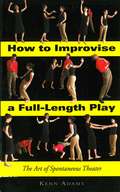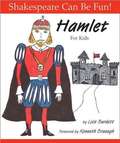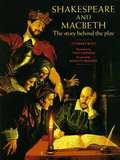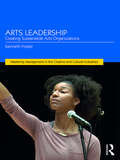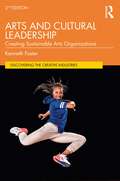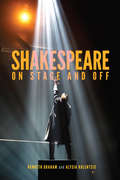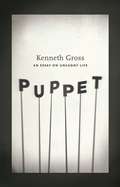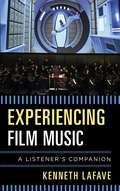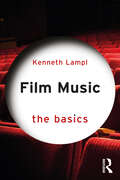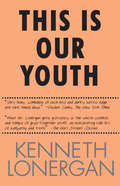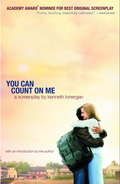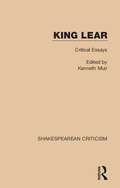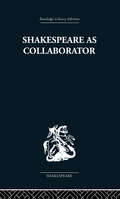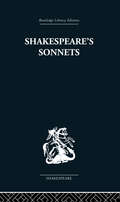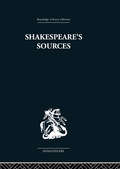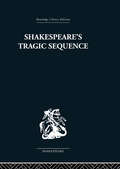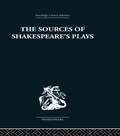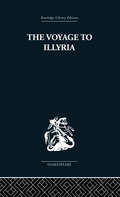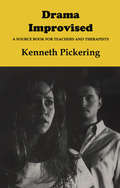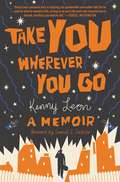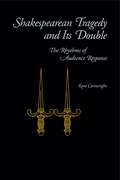- Table View
- List View
How to Improvise a Full-Length Play: The Art of Spontaneous Theater
by Kenn AdamsForget the script and get on the stage! In How to Improvise a Full-Length Play, actors, playwrights, directors, theater-group leaders, and teachers will find everything they need to know to create comedy, tragedy, melodrama, and farce, with no scripts, no scenarios, and no preconceived characters. Author Kenn Adams presents a step-by-step method for long-form improvisation, covering plot structure, storytelling, character development, symbolism, and advanced scene work. Games and exercises throughout the book help actors and directors focus on and succeed with cause-and-effect storytelling, raising the dramatic stakes, creating dramatic conflict, building the dramatic arc, defining characters, creating environments, establishing relationships, and more. How to Improvise a Full-Length Play is the essential tool for anyone who wants to create exceptional theater.
Hamlet For Kids (Shakespeare Can Be Fun! Ser.)
by Kenneth Branagh Lois BurdettPerhaps the best-known of Shakespeare's tragedies, Hamlet has all the ingredients for a gripping story: revenge and power, familial love and betrayal, dramatic sword fights, dark spooky scenes. Once again Lois Burdett has woven her own brand of magic by transforming Shakespeare's complex verse into rhyming couplets. She has created a version of Hamlet especially for children, even as young as seven, and one that readers of all ages will enjoy. At the appropriately named Hamlet Elementary School in Stratford, Ontario, where Burdett has taught for over 20 years, her students have created wonderful drawings of Hamlet to illustrate Burdett's fluid rhymes. The students' interpretations are vivid evidence of Burdett's clever ability to bring Shakespeare's complex characters and intricate plots to life for young people.
Shakespeare And Macbeth: The Story Behind the Play
by Stewart Ross Kenneth Branagh Tony KarpinskiHistorical finding and current critical thinking are woven together to tell the fascinating story of how Shakespeare conceived and wrote one of his greatest plays. As readers watch the production being mounted, Ross's narrative and Karpinski's carefully researched illustrations bring Shakespeare's world to vivid life. Full-color and black-and-white illustrations.
Affecting Grace
by Kenneth C. CalhoonAffecting Grace examines the importance of Shakespeare's poetry and plays within German literature and thought after 1750 - including its relationship to German classicism, which favoured unreflected ease over theatricality. Kenneth S. Calhoon examines this tension against an extensive backdrop that includes a number of canonical German authors - Goethe, Schiller, Herder, Lessing, von Kleist, and Nietzsche - as well as the advent of Meissen porcelain, the painting of Bernardo Bellotto and Francesco Guardi, and aspects of German styles of architecture.Extending from Shakespeare's The Merchant of Venice (c. 1597) to Kleist's The Broken Jug (1806), this study turns on the paradox that the German literary world had begun to embrace Shakespeare just as it was firming up the broad but pronounced anti-Baroque sensibility found pivotally in Lessing's critical and dramatic works. Through these investigations, Calhoon illuminates the deep cultural changes that fundamentally affected Germany's literary and artistic traditions.
Arts Leadership: Creating Sustainable Arts Organizations (Mastering Management in the Creative and Cultural Industries)
by Kenneth FosterThe contemporary world faces unprecedented upheaval and change forcing institutions of all types to rethink how they are designed and how they must now function if they are to survive into an uncertain future. The performing arts are no exception; in an era of constant change and technological transformation, arts organizations and their leaders face significant organizational challenges if they are to maintain their relevance. Arts Leadership: Creating Sustainable Arts Organizations provides a contemporary overview of the field of arts leadership, focused on the performing arts. It examines what these challenges are, how they are affecting the performing arts and arts organizations in general and proposes creative ways to reimagine, build and lead sustainable arts organizations in this uncharted environment. With a global perspective drawn from his extensive experience advising arts organizations around the world and based on his own work successfully leading important performing arts organizations in the United States, Foster proposes an innovative approach to organizational design, systems, and structures for arts leaders in the 21st century that is based in ecological thinking and the creative process that is intrinsic to the arts. In disrupting conventional arts leadership practice, the book provides an exceptional tool to understand a unique sector, and is essential reading for students and practitioners across the creative and cultural industries.
Arts and Cultural Leadership: Creating Sustainable Arts Organizations (Discovering the Creative Industries)
by Kenneth FosterThis textbook provides an expert overview of the challenge of arts and cultural leadership in the contemporary world. Grounded in theories of sustainability and with a renewed global focus for this second edition, the author’s insights from contemporary arts organizations facilitate meaningful student comprehension. Drawing on the work of practitioners and theorists in the fields of philosophy, biology, and ecology as well as the arts, Foster proposes a rethinking of organizational design, strategy, and structure that is based on ecological concepts and the creative process that is intrinsic to the arts rather than the conventional business model that currently prevails, particularly in western arts and culture organizations. He contests conventional thinking about arts administration and management and urges arts leaders to foreground innovation as they reimagine their organizations for a world unlike any other. New sections include an enhanced theoretical discussion as well as new material on business models, strategy, and organizational design and practice. Applicable to any arts organization, the entrepreneurial focus is especially relevant in the aftermath of the global pandemic, the ongoing climate crisis, and the quest for democracy and social justice. This updated edition will be a valuable resource both for present-day arts and cultural leaders who are working to adapt to the current environment as well as students and future leaders who aspire to make change in the world through arts and cultural leadership.
Shakespeare On Stage and Off
by Kenneth Graham and Alysia KolentsisToday, debates about the cultural role of the humanities and the arts are roiling. Responding to renewed calls to reassess the prominence of canonical writers, Shakespeare On Stage and Off introduces new perspectives on why and how William Shakespeare still matters. Lively and accessible, the book considers what it means to play, work, and live with Shakespeare in the twenty-first century. Contributors - including Antoni Cimolino, artistic director of the Stratford Festival - engage with contemporary stagings of the plays, from a Trump-like Julius Caesar in New York City to a black Iago in Stratford-upon-Avon and a female Hamlet on the Toronto stage, and explore the effect of performance practices on understandings of identity, death, love, race, gender, class, and culture. Providing an original approach to thinking about Shakespeare, some essays ask how the knowledge and skills associated with working lives can illuminate the playwright's works. Other essays look at ways of interacting with Shakespeare in the digital age, from Shakespearean resonances in Star Trek and Indian films to live broadcasts of theatre performances, social media, and online instructional tools. Together, the essays in this volume speak to how Shakespeare continues to enrich contemporary culture. A timely guide to the ongoing importance of Shakespearean drama, Shakespeare On Stage and Off surveys recent developments in performance, adaptation, popular culture, and education. Contributors include Russell J. Bodi (Owens State Community College), Christie Carson (Royal Holloway University of London), Brandon Christopher (University of Winnipeg), Antoni Cimolino (Stratford Festival), Jacob Claflin (College of Eastern Idaho), Lauren Eriks Cline (University of Michigan), David B. Goldstein (York University), Gina Hausknecht (Coe College), Peter Holland (University of Notre Dame), R.W. Jones (University of Texas), Christina Luckyj (Dalhousie University), Julia Reinhard Lupton (University of California, Irvine), Linda McJannet (Bentley University), Roderick H. McKeown (University of Toronto), Hayley O'Malley (University of Michigan), Amrita Sen (University of Calcutta), Eric Spencer (The College of Idaho), Lisa S. Starks (University of South Florida St Petersburg), and Jeffrey R. Wilson (Harvard University).
Puppet: An Essay on Uncanny Life
by Kenneth Gross&“Offering endless insights into the strange and archaic world of puppets . . . This is a book of literary mysticism, rich with accrued culture.&” —John Rockwell, The New York Times Book Review The puppet creates delight and fear. It may evoke the innocent play of childhood, or become a tool of ritual magic, able to negotiate with ghosts and gods. Puppets can be creepy things, secretive, inanimate while also full of spirit, alive with gesture and voice. In this eloquent book, Kenneth Gross contemplates the fascination of these unsettling objects—objects that are also actors and images of life. The poetry of the puppet is central here, whether in its blunt grotesquery or symbolic simplicity, and always in its talent for metamorphosis. On a meditative journey to seek the idiosyncratic shapes of puppets on stage, Gross looks at the anarchic Punch and Judy show, the sacred shadow theater of Bali, and experimental theaters in Europe and the United States, where puppets enact everything from Baroque opera and Shakespearean tragedy to Beckettian farce. Throughout, he interweaves accounts of the myriad faces of the puppet in literature—Collodi&’s cruel, wooden Pinocchio, puppetlike characters in Kafka and Dickens, Rilke&’s puppet-angels, the dark puppeteering of Philip Roth&’s Micky Sabbath—as well as in the work of artists Joseph Cornell and Paul Klee. The puppet emerges here as a hungry creature, seducer and destroyer, demon and clown. It is a test of our experience of things, of the human and inhuman. A book about reseeing what we know, or what we think we know, Puppet evokes the startling power of puppets as mirrors of the uncanny in life and art.
Experiencing Film Music: A Listener's Companion
by Kenneth LaFaveOf all the elements that combine to make movies, music sometimes seems the forgotten stepchild. Yet it is an integral part of the cinematic experience. Minimized as mere "background music," film scores enrich visuals with emotional mood and intensity, underscoring directors' intentions, enhancing audiences' reactions, driving the narrative forward, and sometimes even subverting all three. Trying to imagine The Godfather or Lawrence of Arabia with a different score is as difficult as imagining them featuring a different cast. In Experiencing Film Music: A Listener's Companion, Kenneth LaFave guides the reader through the history, ideas, personalities, and visions that have shaped the music we hear on the big screen. Looking back to the music improvised for early silent movies, LaFave traces the development of the film score from such early epic masterpieces as Max Steiner's work for Gone With the Wind, Bernard Herrmann's musical creations for Alfred Hitchcock's thrillers, Jerry Goldsmith's sonic presentation of Chinatown, and Ennio Morricone's distinctive rewrite of the Western genre, to John Williams' epoch-making Jaws and Star Wars. LaFave also brings readers into the present with looks at the work over the last decade and a half of Hans Zimmer, Alan Silvestre, Carter Brey, and Danny Elfman. Experiencing Film Music: A Listener's Companion opens the ears of film-goers to the nuance behind movie music, laying out in simple, non-technical language how composers and directors map what we hear to what we see--and, not uncommonly, back again.
Film Music: The Basics (The Basics)
by Kenneth LamplA comprehensive introduction to film music, this book provides a concise and illuminating summary of the process of film scoring, as well as a succinct overview of the rich history of contemporary film music. Written in a non-technical style, this book begins by presenting a brief history of film music from the last 30 years, covering topics ranging from blockbuster franchises to indie film scores. It explores film music from around the world, including Bollywood and European Avant-garde cinema, and film music in animation, like Disney-Pixar and Japanese anime. It then offers a guide to the language of film music analysis, the creative process behind composing film music, and the use of current technology. The book champions diversity in the industry, with case studies and interviews from a range of active film composers, including: Pinar Toprak (Captain Marvel, 2019), Kris Bowers (Bridgerton, 2020), Natalie Holt (Loki, 2021), and Rachel Portman (Emma, 1996), Complete with a glossary of key terms and further reading, this book is an invaluable resource for all those beginning to study film music, as well as lifelong film music buffs seeking to update their understanding of film music.
This Is Our Youth
by Kenneth LonerganThis is Our Youth, Kenneth Lonnergan's lacerating look at affluent young Manhattanites of the 1980s, was first produced by the New Group in New York in 1996 to great critical acclaim and a Drama Desk Award nomination for best new play. Set in 1982, the play depicts two days in the lives of three college-age Upper West Siders who are from wealthy families but are living in doped-up squalor. Dennis -- with a famous painter for a father and social activist mother -- is a small-time drug dealer and total mess. His hero-worshipping, indifferently adjusted friend Warren has just impulsively stolen $15,000 from his father, an abusive lingerie tycoon who is "not a criminal, just in business with criminals". When Jessica, a mixedup prep-school girl, shows up for a date, Warren pulls out a wad of bills and takes her off, awkwardly, for a night of New York seduction. How will Warren turn out -- will he follow Dennis into dissipation or discover a way out? A wildly funny, bittersweet, and ultimately quite moving story,,This Is Our Youth is remarkable in its understanding of contemporary urban youth.
This is Our Youth
by Kenneth LonerganThis Is Our Youth, Kenneth Lonergan’s lacerating look at affluent young Manhattanites of the 1980s, depicts two days in the lives of three college-age Upper West Siders who are from wealthy families but living in doped-up squalor. Dennis—with a famous painter father and social activist mother—is a small-time drug dealer and total mess. His hero-worshipping friend Warren has just impulsively stolen $15,000 from his father, an abusive lingerie tycoon. When Jessica, a mixed-up prep school girl, shows up for a date, Warren pulls out a wad of bills and takes her off, awkwardly, for a night of seduction. A wildly funny, bittersweet, and moving story, This Is Our Youth is as trenchant as it was upon its acclaimed premiere in 1996.
This is Our Youth
by Kenneth LonerganThis Is Our Youth, Kenneth Lonergan's lacerating look at affluent young Manhattanites of the 1980s, depicts two days in the lives of three college-age Upper West Siders who are from wealthy families but living in doped-up squalor. Dennis--with a famous painter father and social activist mother--is a small-time drug dealer and total mess. His hero-worshipping friend Warren has just impulsively stolen $15,000 from his father, an abusive lingerie tycoon. When Jessica, a mixed-up prep school girl, shows up for a date, Warren pulls out a wad of bills and takes her off, awkwardly, for a night of seduction. A wildly funny, bittersweet, and moving story, This Is Our Youth is as trenchant as it was upon its acclaimed premiere in 1996.
You Can Count on Me: A Screenplay
by Kenneth LonerganAcclaimed playwright Kenneth Lonergan’sYou Can Count on Meis one of the most highly praised independent films of recent years, earning many of the major screenplay awards. This is the lovingly drawn story of a sister and brother’s complicated, fragile, but somehow enduring bond. Sammy and Terry Prescott were orphaned as children. Sammy, now the single mother of a young son, has stayed in their hometown and is an officer at the local bank. Terry has become something of a drifter, surfacing only when he needs money. Sammy’s own life has its complications: she puts off an old boyfriend’s proposal and begins an affair with her new boss. Together in their family home, Terry’s charming irresponsibility collides with Sammy’s confusion over her own actions. What remains unspoken is what they’ve known since they were left with only each other sixteen years before.
King Lear: Critical Essays (Shakespearean Criticism #33)
by Kenneth MuirOriginally published in 1984. With selections organised chronologically, this collection presents the best writing on one of Shakespeare’s most studied plays. The structure displays the changing responses to the play and includes a wide range of criticism from the likes of Coleridge, Hazlitt, Moulton, Granville-Barker, Orwell, Levin, Stampfer, Gardner and Speaight interspersed with short entries from Keats, Raleigh, Freud and others. The final chapter by the editor elucidates his own thoughts on Lear, building on his commentary in the Introduction which puts the collection in context.
Shakespeare as Collaborator
by Kenneth MuirThis edition first published in 1960. This book discusses the extent of Shakespeare's collaboration in the plays of Edward III, The Two Noble Kinsmen, Pericles and the lost Cardenio. It includes chapters on the dramatic value of the plays irrespective of authorship.
Shakespeare's Sonnets (Unwin Critical Library)
by Kenneth MuirThis edition first published in 1979. Discussing Shakespeare's sonnets in relation to sonnets by Italian, French and English poets, Kenneth Muir shows how they were influenced by Shakespeare's reading of Sidney, Erasmus and Ovid and discusses their art in terms of construction, sound patterns and imagery. He considers the relationship of the sonnets to Shakespeare's dramatic writing, while stressing the dramatic element in the sonnets themselves. Finally he surveys the changing attitudes to the sonnets during the last three centuries.
Shakespeare's Sources: Comedies and Tragedies
by Kenneth MuirFirst published in 1957. This book finds discovers what the sources to Shakespeare's Comedies and Tragedies really were, considers the dramatic reasons for Shakespeare's departure from them and provides many examples of the way in which he made use of his general reading for particular scenes and speeches. Kenneth Muir shows that Shakespeare frequently uses more than one source and sometimes as many as eight.
Shakespeare's Tragic Sequence
by Kenneth MuirFirst published in 1972. The emphasis of this book is that each of Shakespeare's tragedies demanded its own individual form and that although certain themes run through most of the tragedies, nearly all critics refrain from the attempt to apply external rules to them. The plays are almost always concerned with one person; they end with the death of the hero; the suffering and calamity that befall him are exceptional; and the tragedies include the medieval idea of the reversal of fortune.
The Sources of Shakespeare's Plays
by Kenneth MuirFirst published in 1977. This book ascertains what sources Shakespeare used for the plots of his plays and discusses the use he made of them; and secondly illustrates how his general reading is woven into the texture of his work. Few Elizabethan dramatists took such pains as Shakespeare in the collection of source-material. Frequently the sources were apparently incompatible, but Shakespeare's ability to combine a chronicle play, one or two prose chronicles, two poems and a pastoral romance without any sense of incongruity, was masterly. The plays are examined in approximately chronological order and Shakespeare's developing skill becomes evident.
The Voyage to Illyria: A New Study of Shakespeare (Select Bibliographies Reprint Ser.)
by Kenneth MuirFirst published in 1937. This study argues that the plays of Shakespeare must be studied by comparison with each other and not as separate entities; that they must be related to one another, to the poems and to the Sonnets; that each individual play acquires a deeper significance from its setting in the corpus. Muir and O'Loughlin's critical analysis takes place against the personality of Shakespeare, asserting that that despite all their diversities a single mind and a single hand dominate them and that they are the outcome of one man's critical and emotional reactions to life.
Drama Improvised: A Sourcebook for Teachers and Therapists
by Kenneth PickeringThis book provides a practical, accessible, and inexpensive guide to using improvisation in drama, which lies at the root of actor training, educational drama and drama therapy, in a wide variety of situations. It is useful for teachers, organizers of drama workshops, therapists and trainers.
Character and the Supernatural in Shakespeare and Achebe (Routledge Studies in Speculative Fiction)
by Kenneth UsongoThrough mainly a New Historicist critical approach, this book explores how Shakespeare and Achebe employ supernatural devices such as prophecies, dreams, gods/goddesses, beliefs, and divinations to create complex characters. Even though these features indicate the preponderance of the belief in the supernatural by some people of the Elizabethan, Jacobean, and traditional Igbo societies, Shakespeare and Achebe primarily use the supernatural to represent the states of mind of their protagonists. Both writers appropriate supernatural features to mirror tragic flaws such as ambition, arrogance, impulsiveness, and fear that contribute to the downfall of Macbeth, Lear, Okonkwo, and Ezeulu. We relate to some of these characters because they project our inner minds, principal drives that may be hidden within us. Therefore, Shakespeare and Achebe’s preoccupation with the supernatural adds subtlety to their characterization and enhances their readability by situating their art beyond time, place, or particularity.
Take You Wherever You Go
by Samuel L. Jackson Kenny Leon"You can do whatever you want to do. The only limits are the ones you set yourself. You have all you need in you right now."When Kenny Leon's grandmother told him to "take you wherever you go," she could hardly have anticipated that he would establish himself as one of Broadway's most exciting and acclaimed directors. But through years of hard work, Kenny would migrate from a small wooden house in rural Florida to the Tony Awards' stage, where he would win Best Direction of a Play for his 2014 revival of A Raisin in the Sun. In TAKE YOU WHEREVER YOU GO, Leon reflects on the pillars of wisdom he learned every step of the way from the most important people in his life-from his grandmother's sagacious and encouraging motivations to the steady hand of his mother to the deep artistic and social influence of iconic American playwright August Wilson. TAKE YOU WHEREVER YOU GO is a poignant, ruminative, and inspirational memoir that empowers you to be true to yourself as you navigate your own path.
Shakespearean Tragedy and Its Double: The Rhythms of Audience Response (G - Reference, Information and Interdisciplinary Subjects)
by Kent CartwrightWhy does Shakespearean tragedy continue to move spectators even though Elizabethan philosophical assumptions have faded from belief? Shakespearean Tragedy and Its Double seeks answers in the moment-by-moment dynamics of performance and response, and the Shakespearean text signals those possibilities.Shakespearean Tragedy and Its Double investigates the poetics of audience response. Approaching tragedy through the rhythms of spectatorial engagement and detachment ("aesthetic distance"), Kent Cartwright provides a performance-oriented and phenomenological perspective. Shakespearean Tragedy and Its Double analyzes the development of the tragic audience as it oscillates between engagement—an immersion in narrative, character, and physical action—and detachment—a consciousness of its own comparative judgments, its doubts, and of acting and theatricality. Cartwright contends that the spectator emerges as a character implied and acted upon by the play. He supports his theory with close readings of individual plays from the perspective of a particular element of spectatorial response: the carnivalesque qualities of Romeo and Juliet; the rhythm of similitude, displacement, and wonder in the audience's relationships to Hamlet; aesthetic distance as scenic structure in Othello; the influence of secondary characters and ensemble acting on the Quarto King Lear; and spectatorship as action itself in Antony and Cleopatra.Shakespearean Tragedy and Its Double treats the dramatic moment in Shakespearean tragedy as uncommonly charged, various, indeterminate, always negotiating unpredictably between the necessary and the spontaneous. Cartwright argues that, for the audience, the very dynamism of tragedy confers a certain enfranchisement, and the spectator's experience emerges as analogous to, though different from, that of the protagonist. Through its own engagement and detachments the audience becomes the final performer creating the play's meaning.
